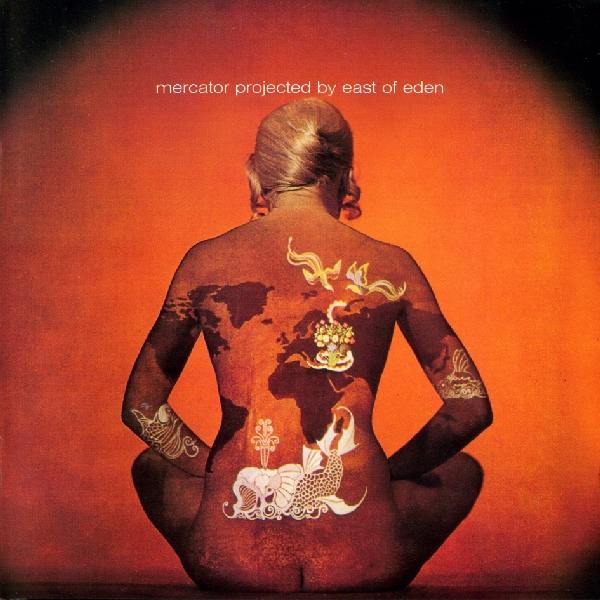
Exposé Online
What's old
Exposé print issues (1993-2011)
- 1 (October 1993)
- 2 (February 1994)
- 3 (May 1994)
- 4 (August 1994)
- 5 (October 1994)
- 6 (March 1995)
- 7 (July 1995)
- 8 (November 1995)
- 9 (March 1996)
- 10 (August 1996)
- 11 (February 1997)
- 12 (May 1997)
- 13 (October 1997)
- 14 (February 1998)
- 15 (July 1998)
- 16 (January 1999)
- 17 (April 1999)
- 18 (November 1999)
- 19 (May 2000)
- 20 (October 2000)
- 21 (March 2001)
- 22 (July 2001)
- 23 (December 2001)
- 24 (April 2002)
- 25 (September 2002)
- 26 (February 2003)
- 27 (August 2003)
- 28 (December 2003)
- 29 (April 2004)
- 30 (September 2004)
- 31 (March 2005)
- 32 (September 2005)
- 33 (May 2006)
- 34 (March 2007)
- 35 (January 2008)
- 36 (October 2008)
- 37 (July 2009)
- 38 (July 2010)
- 39 (Summer 2011)
Reviews
East of Eden — Mercator Projected
(Eclectic Discs ECLCD 1012, 1969/2004, CD)

East of Eden's debut is one of the great late-60s albums, following on the way the Beatles started occasionally fusing their music with the sounds of other cultures. However, where the Beatles tended to incorporate the music of India, East of Eden used the mythology of Greece and Egypt to give their songs a true historical-exotic feel. Much of this was accomplished by the wide range of instruments played by Dave Arbus, including flute, violin, and others, some of it by the use of different musical scales, and part of it was just the atmosphere of the time period. It's perhaps somewhat telling that the bonus track here is their cover of "Eight Miles High," as that song is a good example of the paradigm of the day in a pop format with the hazy atmosphere and sense of wonder of the psychedelic era. A classic almost throughout, although "Isadora" and closer "In the Stable of the Sphinx" have to be two big highlights.
by Mike McLatchey, Published 2017-08-10
An engaging and groundbreaking early British progressive band, East of Eden used electric violin, dual saxes, flute, recorder and bagpipe to add texture to their guitar based rock. The end product is an almost unprecedented sound. they would have been lionized were it not for another, quite coincidentally similar band called King Crimson, who released their classic debut the same year. The accidental closeness of this band to Crimson is remarkably uncanny. Singer Geoff Nicholson is not unlike Greg Lake vocally, but more expressive and without the pompous troubadour-ish tendencies. And while he's no Robert Fripp by a longshot, his guitar playing is more than adequate. The use of woodwinds is the closest correlation, especially the multiple sax work on tracks like "Waterways," which is strongly reminiscent of Ian McDonald's work. There are even Sinfield-ian "liquid word-pictures" (that's the term they use in the liner notes to the original LP), the exception being the lyrics to "Centaur Woman," which are actually quite humorous. The pieces on Mercator Projected range from heavy guitar rock ("Northern Hemisphere") to otherworldly atmospheric studies for violin and woodwinds ("Bathers," "Isadora"). It's the latter songs that make up the bulk of the album, and part of what make it so refreshing, so original compared with their contemporaries. Which is not to slight their more rocking numbers, the outrageous bass solo on "Centaur Woman" and the tricky rhythms of the primarily instrumental "In the Stable of Sphinx" prove these too have worth. East of Eden carried on for many years after Mercator Projected, eventually scoring a fluke early-70s top-ten hit single in "Jig-A-Jig." But they never got the respect they deserved based on this very good album, which surprisingly has dated very little.
by Mike Ohman, Published 1995-11-01
Filed under: Reissues, 2004 releases, 1969 recordings
Related artist(s): East of Eden, Ron Caines
What's new
These are the most recent changes made to artists, releases, and articles.
- Release: Family - Old Songs, New Songs
Updated 2025-12-29 00:03:41 - Review: The Kirkbys - It's a Crime: The Complete Recordings
Published 2025-12-29 - Release: Various Artists - Psychedelic Underground 20
Updated 2025-12-28 23:33:26 - Artist: Dhope
Updated 2025-12-28 23:27:49 - Artist: Tin Pan Alley
Updated 2025-12-28 23:21:39 - Release: Various Artists - Psychedelic Underground 19
Updated 2025-12-28 23:04:15 - Review: Earthbound - Earthbound
Published 2025-12-28 - Review: Olgoj - A Place to Rest
Published 2025-12-27 - Release: John Weider - John Weider
Updated 2025-12-26 19:13:54 - Artist: John Weider
Updated 2025-12-26 19:09:52 - Release: Moonrider - Moonrider
Updated 2025-12-26 18:51:45 - Artist: Moonrider
Updated 2025-12-26 18:49:51 - Release: Octopus Syng - Insanity Is the Song We Sing
Updated 2025-12-26 12:53:35 - Release: Tre Spiritus - Tre Spiritus
Updated 2025-12-26 12:49:13 - Artist: Tre Spiritus
Updated 2025-12-26 12:48:34 - Release: Arpia - Festa Grande
Updated 2025-12-26 12:42:27 - Release: Sigmund Freud - Risveglio
Updated 2025-12-26 12:37:54 - Artist: Sigmund Freud
Updated 2025-12-26 12:37:08 - Release: Davide Cedolin - Ligurian Pastoral, Vol II
Updated 2025-12-26 00:17:38 - Release: Davide Cedolin - Ligurian Pastoral
Updated 2025-12-26 00:15:05
